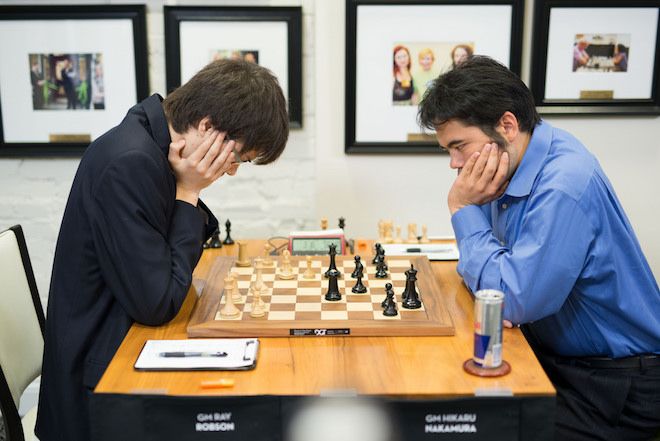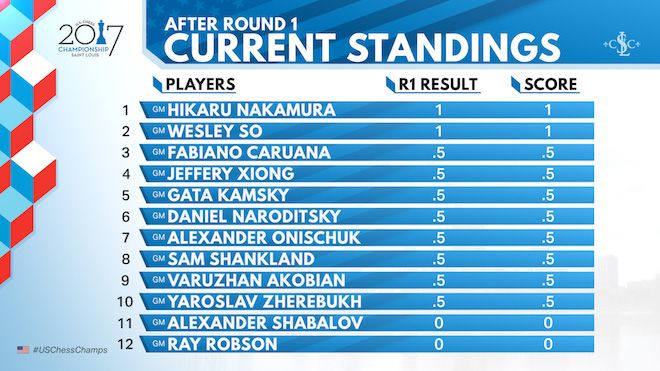U.S. Chess Championship Starts With Wins From So And Nakamura
The "big three," as they are commonly known in American chess, are seen collectively as prohibitive favorites to win the 2017 U.S. Championship, which began yesterday.
It's early in St. Louis, but two of them validated that sentiment, while the defending champion struggled to make a draw. There were some matchups of familiar faces -- all five U.S. Olympiad gold medalists from Baku played on three boards.
Lead photo courtesy Austin Fuller for Chess Club and Scholastic Center of Saint Louis.
The only two wins from the 12-player field came from GMs Wesley So and Hikaru Nakamura. For top-seeded So, who doesn't even know where his unbeaten streak stands (it's nearing 60 classical games), it was a rout of the bottom seed. Third-seeded Nakamura needed to grind out an ending, and by his own admission used some luck to win against Olympiad teammate GM Ray Robson.
Defending champion GM Fabiano Caruana, sandwiched in between the two in the rankings, was worse much of the game but held against fellow Olympiad teammate GM Sam Shankland.

Graphics courtesy Spectrum Studios.
In the U.S. Women's Championship, none of their own "big three" began with a win, although there's a strong argument for claiming a fourth player deserves to change that moniker. While seven-time winner GM Irina Krush and defending champion IM Nazi Paikidze both drew, IM Anna Zatonskih even lost due to an egregious error deep into her rook-and-lone pawn ending.
The fourth would-be Musketeer, WGM Tatev Abrahamyan (who was within a whisker of winning last year) is one of the early leaders. She is joined in the 1-0 column by WGM Sabina Foisor and WIM Jennifer Yu.

In a top-versus-bottom matchup, So was the first winner when he beat four-time winner GM Alexander Shabalov. The veteran qualified last year too by winning the automatic qualifier from the 2015 U.S. Open, but then performed below his own expectations at the Championship. He told Chess.com he wouldn't try to qualify again if he didn't think he could be competitive, but then the hall of famer turned around and won the 2016 U.S. Open to qualify again this year!
It's no fun to play the hottest player on the planet in round one as Black, so it's too early to judge if he can turn things around.
Games via TWIC.
"It's definitely the strongest national championship in the world," So said of his desire to win in his third attempt. In 2015 he went +2 and last year +4. Commentator GM Maurice Ashley joked he may try for +6 this year.
Shabalov can perhaps find succor in commentator GM Ben Finegold's Facebook post about his PRO League teammate: "I've played Shabalov for 28 years. I've never won. Wesley So beat Shabalov today like he was from another planet. Wesley So is a monster. He's the scariest player I've ever seen."
Nakamura didn't have it quite as easy but strangely appreciated getting Black.
"It's going to come down to who gets the right Blacks against the right opponents so you can try and press," he explained. He was able to do just that today against Robson.
(Interestingly Robson played his fourth consecutive White yesterday! His team slotted him with three Whites in three games at last weekend's triumphant President's Cup.)

Our reader's with 20-20 vision may be able to tell that Robson only had three digits on his clock at this point (under 10 minutes) while Nakamura had close to an hour. Photo courtesy Austin Fuller for Chess Club and Scholastic Center of Saint Louis.
The four-time champ took over the initiative and had to find a nifty exchange sacrifice in the ending to win bishop-and-three versus rook, but this all came virtue of Robson's usual time deficiencies.
Robson took "and hour and half for three or four moves" as Nakamura recalled, adding, "I think his wounds were self-inflicted.
"I don't know if he hadn't looked at this ...f5 line or if he just hasn't looked at chess in a long time."
In other action, chess-player-turned-reality-star Shankland thought his tripling of the c-file could have netted him more than a split point with Caruana. Shankland spent eight days in the Fijian jungle after last year's U.S. Championship, so now his opponents can prepare for him by checking out the database and also his IMDB page.

GM Sam Shankland didn't win today, but on the bright side, he did get to wear as many clothes as he wanted. Photo courtesy Austin Fuller for Chess Club and Scholastic Center of Saint Louis.
Caruana said things weren't as bleak as in some of his games.
"I didn't like my position after he took on f6," Caruana said. "I thought I had no counterplay. I just wanted to start something with ...g5.
"I've had much worse positions. That was one of my better [worse] positions, so I'm used to it!"
For the record, Shankland was eliminated during the second episode, but luckily no one is asked to leave the U.S. Championship early.
In other action, GM Jeffrey Xiong had GM Varuzhan Akobian down a pawn and also down to three seconds, but the veteran held the draw with help from the increment. Past-winner GM Alex Onischuk drew the shortest game, with GM Daniel Naroditsky. Newcomer GM Yaroslav Zherebukh, the wildcard invitee, drew with five-time champion GM Gata Kamsky.
Amazingly, after many years of dominating the event, Kamsky is now in the lower half of the draw, seeded eighth. He said he was lucky just to qualify by rating (he's only 14 points above Akobian, the final rating qualifier).

Of the dozen players in the field, only three have multiple titles. GM Gata Kamsky (pictured) has five, while Nakamura and Shabalov has four each. Onischuk and Caruana both have one. Photo courtesy Lennart Ootes for Chess Club and Scholastic Center of Saint Louis.
"My expectation is that I get some rating points, I get some money," he said, discounting any chance of getting another title. He said he sees a lot of his past self in the energy the younger players have.
In the U.S. Women's Championship, four-time winner Zatonskih is the oldest in the event, like Kamsky, but making no such proclamations about not winning. However, she did make the same lament about not having as much energy as her younger counterparts. Her chances took a big hit late in the first day.
"I just forgot about Kc2," she said. "Just lost control and concentration at the end of the game. This is just the advantage of youth."
There are five teenagers in the women's field (the bottom five seeds) but at the end of day one Yu leads them not just in rating but also in points.

WIM Jennifer Yu, looking to lead the next generation of American women. Photo courtesy Lennart Ootes for Chess Club and Scholastic Center of Saint Louis.
In other action, Abrahamyan loves the Open Sicilian, and her young opponent didn't shy away from it in round one. The Californian didn't get to represent her country in Baku but so far she's on her way to becoming a factor in the national championship once again.
Abrahamyan found a tactic to effectively seal things up in the first time control. In fact, her idea beginning on move 20 was the only clearly winning continuation:
Last year's first-half surprise, 13-year-old WFM Carissa Yip, nearly got off to another quick start over Olympian Foisor. After an exchange sacrifice netted the youngest player a solid and promising position, Foisor gave back the rook to reach an equal queen-and-rook ending.
That's when Yip made an error in geometry, allowing the White queen to travel upon a hypotenuse to force mate.
In additional news, the opening ceremony Tuesday night also served its traditional dual role of hall of fame inductions. No active players made the ceremony like the last few years (Kamsky, Shabalov). Instead, the U.S. Chess Hall of Fame added IM Edward Lasker. A distant relative of the former world champion, Lasker won five U.S. Open titles but is perhaps best known for this game. He could have castled to give mate but instead found more aesthetics in the efficiency of Kd2:
The World Chess Hall of Fame had a busier night, inducting three new members posthumously. Paula Kalmar-Wolf and Alla Kushnir joined GM Viktor Korchnoi in adorning the institution's walls.
Kalmar-Wolf finished in the top three of the Women's World Championship in the late 1920s and early 1930s. Kushnir finished runner-up three times herself, coming close but never overcoming GM Nona Gaprindashvili.

IM Nazi Paikidze at the opening ceremony, in front of pictures of two of the hall of fame inductees. Photo courtesy Lennart Ootes.
Korchnoi rounds out the "runner-up" biographies, as he also lost a trio of world championship matches, to his nemesis was GM Anatoly Karpov. He lived a storied life and had one of the longest careers in the history of high-level chess. Korchnoi died just last year and in a few weeks a tournament in Zurich, his adopted hometown, will bear his name.


The biggest matchup for today will undoubtedly be Caruana-Nakamura. Caruana said yesterday that he's probably played Nakamura more than any other player (not on the junior circuit; most of their 30+ classical games have come in the last four years).

The top-rated ladies manage to avoid each other for another round. Instead, fellow Olympiad teammates with square off. WGM Katerina Nemcova and IM Nazi Paikidze is one of the featured matchups, along with GM Irian Krush against WGM Sabina Foisor.

You can catch the full broadcast at 11am Pacific, 2pm Eastern at either at Chess.com/TV or at the official site, uschesschamps.com.
Previous reports:


